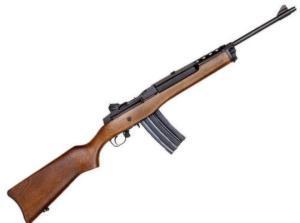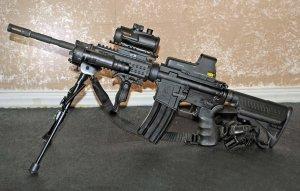
Ruger Mini 14

An AR-15 style rifle
As I have pointed out before, the problem with banning ‘assault weapons’ lies with the difficulty in defining one in the first place. Many firearms are not considered assault weapons legally speaking, but in practical terms only differ from assault weapons cosmetically. For example, the image above features the Ruger Mini 14. The image below is an AR-15 style rifle. The AR-15 looks menacing: it features an additional flashlight, a foregrip, a bipod, and some new sights. Aside from the extras, however, there is no practical difference between the two; they are both semi-automatic (each trigger pull produces a shot), they feature a 30 round magazine, and are both chambered in 5.56mm (or .223 if you’re not a fan of the metric system). The lower image features a weapon the new assault weapons law would ban, the above image features a weapon that would still be fully legal.
The Huffington Post notes this massive loophole in a new article:
Congress’ latest crack at a new assault weapons ban would protect more than 2,200 specific firearms, including a semi-automatic rifle that is nearly identical to one of the guns used in the bloodiest shootout in FBI history.
One model of that firearm, the Ruger .223 caliber Mini-14, is on the proposed list to be banned, while a different model of the same gun is on a list of exempted firearms in legislation the Senate is considering. The gun that would be protected from the ban has fixed physical features and can’t be folded to be more compact. Yet the two firearms are equally deadly.
“What a joke,” said former FBI agent John Hanlon, who survived the 1986 shootout in Miami. He was shot in the head, hand, groin and hip with a Ruger Mini-14 that had a folding stock. Two FBI agents died and five others were wounded.
Politically and practically, assault weapons bans will always feature this loophole for one key reason: no one is willing to ban all semi-automatic rifles. You can, in fact, hunt with a Ruger mini 14 (or its 7.62mm caliber variant). No politician is willing to take away hunting rifles, plain and simple.
Another problem with assault weapons bans is that this loophole is easily exploitable by weapons manufacturers. If the law says a rifle cannot have a bayonet lug (it allows a bayonet, or knife to be attached to the barrel) they will simply remove them and, magically, the rifle is no longer an assault weapon! The same goes for other items the law uses to identify assault weapons, such as short barrels, flash hiders, and pistol grips.
The National Firearms Act also says that fully automatic weapons must be registered as ‘Class III.’ To get around this, manufacturers have designed fully legal ‘bump fire’ stocks. Behold the power of innovation gone wrong.
I am not suggesting that an assault weapons ban is a bad idea. It probably does no harm, but the positive affects are probably overstated as well. In my view, registration probably would do more good while at the same time retaining individual choice. The onerous process that is used to register ‘Class III’ weapons ensures that only law abiding people can get machine guns. These weapons have, to my knowledge, never been used in a crime.
This is an issue that, to the layperson, can be confusing. If you are not a ‘gun person’, it seems like a straightforward idea to ban these weapons. I hope I have been able to explain how difficult this truly is.
